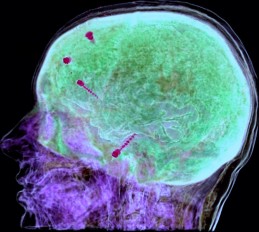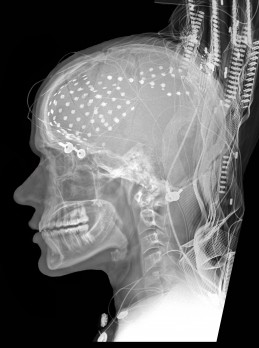How the human brain computes language
October 16, 2009 | Source: KurzweilAI

X-ray and brain scan showing electrodes that surgeons use to find and remove the source of seizures (to cure epilepsy), while sparing the source of mental functions like language (Ned T. Sahin)
Direct recordings from sets of brain cells revealed that three fundamentally distinct aspects of language (meaning, structure, and word sounds) are computed in Broca’s area in the brain and in a tightly-timed sequence.
They used a procedure called Intra-Cranial Electrophysiology (ICE)*, in which electrodes were placed in the brains of patients, allowing the researchers to resolve brain activity related to language with spatial accuracy down to the millimeter and temporal accuracy down to the millisecond, and providing a picture of language processing in the brain with unprecedented clarity.
 (Brain-imaging methods such as functional MRI blur the activity of thousands or millions of neurons over long periods of time. Consequently, scientists have been unable to determine in detail whether the mechanisms used by linguistic or computational models to produce grammatically correct speech correspond to the mechanisms that the brain actually uses.)
(Brain-imaging methods such as functional MRI blur the activity of thousands or millions of neurons over long periods of time. Consequently, scientists have been unable to determine in detail whether the mechanisms used by linguistic or computational models to produce grammatically correct speech correspond to the mechanisms that the brain actually uses.)
The researchers found patterns of neuronal activity indicating lexical, grammatical and articulatory computations at roughly 200, 320 and 450 milliseconds after the target word was presented. These patterns were identical across nouns and verbs and consistent across patients.
The study will be published in the October 16 issue of the journal Science.
*The ICE technique is used to allow surgeons to know which small region of the brain to remove to alleviate their seizures, while sparing the healthy regions necessary for language or other essential functions.